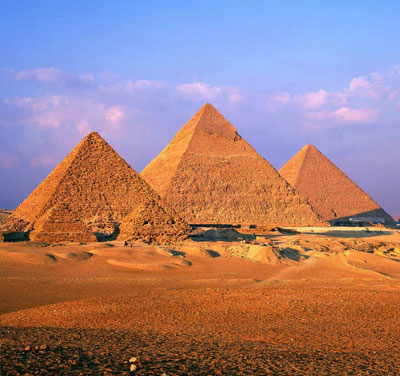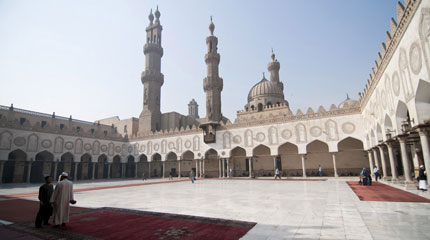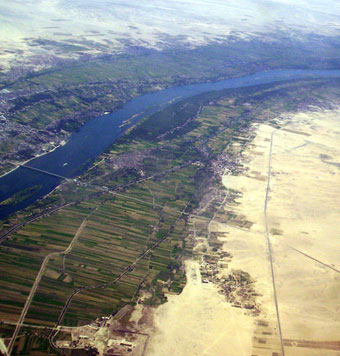Egypt
Country statistics

Land area: 384,344 sq miles (995,451 sq km)
Total area: 386,662 sq miles (1,001,450 sq km)
Population (2010 est.): 80,471,869 (growth rate: 1.9%); birth rate: 25.0/1000; infant mortality rate: 26.2/1000; life expectancy: 72.4; density per sq km: 82
Capital City: Cairo (Al-Qahirah)
Monetary unit: Pound
Languages: Arabic (official), English and French widely understood by educated classes
Ethnicity/race: Eastern Hamitic stock (Egyptians, Bedouins, and Berbers) 99%, Greek, Nubian, Armenian, other European (primarily Italian and French) 1%
Religions: Islam (mostly Sunni) 94%, Coptic Christian and other 6%
Country introduction

Egypt is located in Africa and it is bordered by Libya to the west, the Gaza Strip and Israel to the east, and Sudan to the south. The longest river in the world, the Nile River at 6,500 km (4,038 miles), starts from Egypt from the Red Sea, and flows through to Sudan, Ethiopia, Burundi, Uganda and Kenya. It was by its banks that one of the oldest civilizations in the world began. More than 2,900 km (1,801 miles) of coastline on the Mediterranean Sea, the Gulf of Suez, the Gulf of Aqaba and the Red Sea constitute Egypt's maritime boundaries.
Egypt is caharcterized by the The Nile Valley, The Arabian Desert, The Libyan Desert, and The Sinai. The ancient Egyptians thought of Egypt as being divided into two types of land, the 'black land' and the 'red land'.
The fertile land on the banks of the Nile was referred to as the 'black land'. The ancient Egyptians used this land for growing their crops. This was the only land in ancient Egypt that could be farmed because a layer of rich, black silt was deposited there every year after the Nile flooded.
The barren desert was referred to as the 'red land', which protected the Kingdom of the Pharaohs from western threats on both sides. These deserts separated ancient Egypt from neighbouring countries and invading armies. They also provided the ancient Egyptians with a source for precious metals and semi-precious stones. About 95% of Egypt is desert land. The Sahara Desert covers more than two thirds of Egypt. The other deserts are the Libyan Desert, the Arabian Desert, and the Nubian Desert.
The highest lands are in the south and the land slopes gently toward the Mediterranean Sea. There are some mountains located on the Southern Sinai peninsula. Some of these reach over 2600 m (8530 ft) high. The land at the Mediterranean is at sea level.
Egypt is one of the oldest civilizations, dating back over 6000 years. The country is famous for some of the world's most stunning ancient monuments, including the Giza Pyramids, the Karnak Temple, the Valley of the Kings and the Great Sphinx of Giza. The southern city of Luxor contains a particularly large number of ancient artifacts.
Today, Egypt is widely regarded as the main political and cultural centre of the Arab and Middle Eastern regions.
The culture

Egypt's capital city, Cairo, is Africa's largest city and has been renowned for centuries as a center of learning, culture and commerce.
Egypt hosts two major religious institutions. Al-Azhar University is the oldest Islamic institution for higher studies (founded around 970 AD), and it also has a strong Christian heritage as evidenced by the existence of the Coptic Orthodox Church headed by the Patriarch of Alexandria.
In general, Egyptians are mostly accommodating and they will go out of their way to help and respond to any questions.
Although most of the Muslims in Egypt do not drink alcohol they don't object to others drinking, as long as they do so in reasonable amounts. People don't eat pork either, and rarely, when places are found to offer pork, is there much choice on the menu.
Egyptians, like rest of the Muslims all over the world are united during the holy month of Ramadan. It is a time of spiritual reflection and worship through fasting and praying. Also during this month people practice sacrifice, and empathy for those who are less fortunate, thus encouraging actions of generosity and charity (Zakat). It is a wonderful month for everyone.
In Egypt there are hardly any restrictions on foreign women. Ticket lines, for example, are occasionally segregated, women line up with other women (especially as the lines are usually shorter). On the underground lines, the first car is usually reserved for women, especially elderly ones. For men, speaking to an unknown Egyptian woman is a breach of etiquette as some families still follow ancient traditions.
Crime in Egypt is nearly nonexistent, and violence is usually limited to family feuds. However, in tourism areas some pickpockets and petty thieves may exist, but the ever-helpful tourism police are usually nearby. Women must be cautious, especially in out-lying areas.
Attractions & landmarks

Egypt is symbolized by the pyramids. The Great Pyramids were built for the Kings, or Pharaoh so that when they died they could be buried inside of them to be worshipped as gods (see Ancient Egypt).
The capital city, Cairo is the most convenient base for seeing the Great Pyramids. From Cairo it is only a 20 minutes drive to Giza, where visitors will find these spectacular testaments to a formerly great civilization. While in Cairo, and after visiting the pyramids, it is worth spending a few days exploring the rest of the city. Coptic Cairo is the oldest part of the city and is where visitors will find what remains of the Fortress of Babylon. The last two remaining towers are the highlight of this site, although the museum just at the base of them is worth a look for its collection of religious artifacts and art. Other sites in Cairo include the Al-Azhar Mosque, the Mosque of Qaitbey and the Citadel.
In the past Luxor, which situated on the River Nile, was the Egyptian stronghold, a centre of emense power. Luxor is where Tutankhamun's burial chamber lies, in the Valley of the Kings. A walk in Luxor is a walk through history allowing the view of unique and wonderful statues, temples and carvings everywhere. The main attraction is the Temples of Karnack which were built during Theban times as centres of worship. Also worth looking at are the Luxor temple which was built by Amenhotp III and the Colossi of Memnon.
Alexandria, the second largest egyptian city, is the main port of Egypt and is situted in the north-west of the Nile delta. There are beautiful white sandy beaches and captivating scenery strethching for 140 km (86 miles) along the Mediterranean Sea. Abu-Qir Suburb is one of the most peaceful beaches and is well-known for fishing and delicious seafood restaurants. This area also offers the opportunity to see many Greek and Roman monuments.